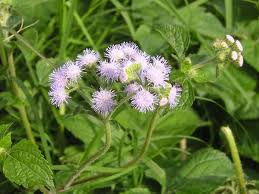| PlantID | 0009 |
| Botanical Name | Ageratum conyzoides |
| Common Name | Aru batu |
| Classification | | Kingdom: | Plantae | | Subkingdom: | Tracheobionta | | Division: | Magnoliophyta | | Class: | Magnoliopsida | | Subclass: | Asteridae | | Order: | Asterales | | Family: | Asteraceae | | Genus: | Ageratum | | Species: | conyzoides |
|
| Part used | Whole plant, roots, leaves. |
| Medicinal Properties | Analgesic, Antibacterial, Anti-inflammatory, Emetic, Purgative, Decoagulant, depurative, Febrifuge, Stimulant, Vulnerary. Roots: Antilithic. Leaves: styptic. |
| Medicinal Use | Pneunomia, Burns, Fever, Rheumatism, Headache, Colic, Colds, Diarrhea, Rheumatism, Spasms. Whole plant: applied externally in ague. Roots: juice. Leaves: applied to wounds |
| Chemistry | Beta-pinene, Beta-selinae, Beta-sitosterol, Cadinene, Caryophyllene-oxide, Conyzorigin, 6,7-Dimethoxy-2, 2-methylchromene, 6-demethoxy-ageratochromene, 6-vinyl-demetjoxy-ageratocchromene, Farnesol, Kaempferol, Quecetin-3, 7-diglucoside. |
| Cultivation | Succeeds in full sun in a sheltered position in any reasonably fertile moisture-retentive soil the does not dry out in the summer. Plant vigour and flowering periods are much reduced on dry soils. This speces is not frost hardy. The fresh plant is malodorous. |
| Regional Habitat | Occurs often gregariously in moist and shady places. Distribution: Jhunjhunu, Sikar, Jaisalmer, Jodhpur, Sirohi, Udaipur, Dungarpur, Jaipur, Bundi, Jhalawar, Bhilwara, Bharatpur, Banswara districts of Rajasthan. |
| Description | Eract herb, young stems pubscent. Leaves ovate, acute at apex, acute to obtuse or subcordately rounded at base, pubscent on both surfaces, glandular dorsally, 2-10 cm long, 1-56 cm wide, on petiole. 1-5 cm long, heads corymbs 4-6mm long, involucre subglabrous, bracts acute-acuminate, 3mm long, florets about 75 per head, corolla about 1mm long, white or blue-purplish, style-branches exserted, achenes 1.5-2mm long, nearly glabrous. Fruits: cypsels blackish brown, 0.1 cm long, linear-oblong, 4-5 ribbed. Flowers and fruits appears almost throughout the year. |
| Image |  |


